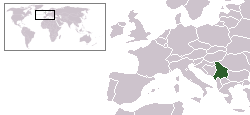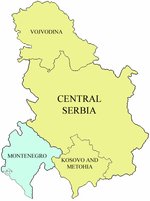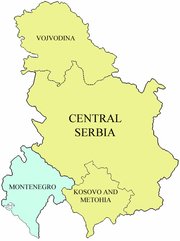Serbia and Montenegro
|
|
Serbia and Montenegro (Serbian: Србија и Црна Гора, Srbija i Crna Gora, often abbreviated as "SCG") is the name of the union of Serbia and Montenegro, two former Yugoslav republics united since 2003 in a loose confederation. It is located on the west-central Balkan Peninsula.
Serbia and Montenegro cooperate in only some political fields (e.g. through a defence union). The states have separate economic policies and currencies. The country does not have a unified capital anymore, dividing its common institutions between Belgrade in Serbia and Podgorica in Montenegro. Each of the two states may seek full independence via a referendum, which can be held in 2006 at the earliest.
| |||||

| |||||
| Template:Serbia and Montenegro 2 | |||||
| Official language | Serbian (implicitly)1 | ||||
| Capital | Belgrade2 | ||||
| President3 | Svetozar Marović | ||||
| Area – Total – % water | Ranked 105th 102,350 km² 0.25% | ||||
| Population – Total (2005) – Density | Ranked 74th 10,829,175 104/km² | ||||
| Currency | Serbia: Serbian Dinar (CSD) Montenegro: Euro (EUR) | ||||
| Time zone – in summer | CET (UTC+1) CEST (UTC+2) | ||||
| National anthem | Hej Sloveni | ||||
| Internet TLD | .yu still used (.cs reserved) | ||||
| Airline carriers | Jat Airways and Montenegro Airlines | ||||
| Calling Code | +381 | ||||
|
1 Serbian is the official language of Serbia (using Cyrillic alphabet) and of Montenegro (using Cyrillic and Latin alphabet). More languages are official at various local levels. | |||||
| Contents |
History
Main articles: History of Serbia and Montenegro, History of Yugoslavia
Upon the breakup of the Socialist Federal Republic of Yugoslavia, the remaining confederation of Serbia and Montenegro was reconstituted in 1992 as the Federal Republic of Yugoslavia (FRY). However, the United Nations, and many individual states (especially the United States) had refused to recognise it as the successor of the former Yugoslavia, although they accepted it as constituting a state. This was due to the ongoing Yugoslav wars, which had prevented agreement being reached on the disposition of federal assets and liabilities, particularly the national debt. The FRY was also suspended from a number of international institutions because of its perceived role in the wars. It was finally re-admitted to the United Nations in 2000 after several years of suspension.
In 2002, Serbia and Montenegro came to a new agreement regarding continued co-operation, which, among other changes, promised the end of the name Yugoslavia. On February 4, 2003, the federal parliament of Yugoslavia created a loose commonwealth of Serbia and Montenegro called Serbia and Montenegro. A new Constitutional Charter was agreed to provide a framework for the governance of the country.
Political divisions
Main article: Internal structure of Serbia and Montenegro
Serbia and Montenegro comprises four principal political units, consisting of two republics and two subordinate provinces:
- Serbia (capital: Belgrade)
- Vojvodina - autonomous province within Serbia (capital: Novi Sad)
- Kosovo - province within Serbia under United Nations administration (capital: Priština)
- Montenegro (capital: Podgorica)
The country's political and administrative capital is Belgrade, while its judicial capital is Podgorica.
Geography
Main article: Geography of Serbia and Montenegro
Serbia and Montenegro covers an area of 102,350 sq km, with 199 km of coastline. The country's terrain is extremely varied, with much of Serbia comprising plains and low hills (except in the more mountainous region of Kosovo) and much of Montenegro consisting of high mountains. Serbia is entirely landlocked, with the coastline belonging to Montenegro, which also possesses the only fjord in southern Europe. The climate is similarly varied. The north has a continental climate (cold winters and hot summers); the central region has a combination of a continental and Mediterranean climate; the south enjoys an Adriatic climate along the coast, with inland regions experiencing hot, dry summers and autumns and relatively cold winters with heavy snowfall inland.
The country's biggest city by far is Belgrade, with a population of 1,711,800. No other city is anywhere near the same size; the country's other largest cities are Novi Sad, Nis, Kragujevac and Podgorica, each with populations of about 140,000-180,000 people.
Demographics
Main article: Demographics of Serbia and Montenegro
Serbia and Montenegro has more demographic variety than many other European countries. Its three largest ethnic groups are Serbs (62.6%), Albanians (16.5%) and Montenegrins (5%) according to the 1991 census. The country also has significant populations of Hungarians, Roma, Romanians, Croats and Slovaks, mostly concentrated in the northern province of Vojvodina, as well as smaller numbers of other minority groups. The large Albanian population is chiefly concentrated in Kosovo, with smaller populations around Presevo in Serbia proper and in the south-east of Montenegro.
- Serbia (total) 9 396 411
- Vojvodina: 2 116 725
- Central Serbia: 5 479 686
- Kosovo: 1 800 000
- Montenegro 623 246
- Total Serbia-Montenegro = 10 019 657
- Main cities (over 100 000 inhabitants) - estimate May 2005
- Beograd (Belgrade): 1 586 382
- Novi Sad: 302 294
- Ni?: 252 275
- Pri?tina: 251 784
- Kragujevac: 176 682
- Podgorica: 153 549
- Subotica: 150 488
Economy
Main article: Economy of Serbia and Montenegro
Mismanagement of the economy, an extended period of economic sanctions, and the damage to Yugoslavia's infrastructure and industry caused by the Kosovo War have left the economy only half the size it was in 1990. Since the ousting of former Federal Yugoslav President Slobodan Milosevic in October 2000, the Democratic Opposition of Serbia (DOS) coalition government has implemented stabilization measures and embarked on an aggressive market reform program. After renewing its membership in the International Monetary Fund in December 2000, Yugoslavia continued to reintegrate into the international community by rejoining the World Bank (IBRD) and the European Bank for Reconstruction and Development (EBRD). A World Bank-European Commission sponsored Donors' Conference held in June 2001 raised $1.3 billion for economic restructuring. An agreement rescheduling the country's $4.5 billion Paris Club government debts was concluded in November 2001; it will write off 66% of the debt; a similar debt relief agreement on its $2.8 billion London Club commercial debt has been reached in July 2004; 62% of the debt have been written off.
The smaller republic of Montenegro severed its economy from federal control and from Serbia during the Milosevic era. Now both republics have separate central banks, different currencies - Montenegro uses the euro, while Serbia uses the Serbian dinar as official currency. The two states also have different customs tariffs, separate state budgets, police forces, governments.
The southern Serbian province of Kosovo, while formally still part of Serbia (according to United Nations Security Council Resolution 1244), is moving toward local autonomy under the United Nations Interim Administration Mission in Kosovo (UNMIK) and is dependent on the international community for financial and technical assistance. The euro and the Yugoslav dinar are official currencies, and UNMIK collects taxes and manages the budget.
The complexity of Serbia and Montenegro's political relationships, slow progress in privatisation, and stagnation in the European economy are holding back the economy. Arrangements with the IMF, especially requirements for fiscal discipline, are an important element in policy formation. Severe unemployment remains a key political economic problem. Corruption also presents a major problem, with a large black market and a high degree of criminal involvement in the formal economy.
Transportation
Main article: Transportation in Serbia and Montenegro
Serbia, and in particular the valley of the Morava is often described as "the crossroads between the East and the West" - one of the primary reasons for its turbulent history. The valley is by far the easiest way of land travel from continental Europe to Greece and Asia Minor. Until the outbreak of the Yugoslav wars, the ironically-named Highway of Brotherhood and Unity running through Croatia, Serbia and Macedonia was one of the Europe's most important transport arteries. It is gradually resuming this role as the security situation is stabilized.
Major international highways going through Serbia are E75 and E70. E763/E761 is the most important route connecting Serbia with Montenegro.
The Danube, an important international waterway, flows through Serbia.
The largest sea harbour is Montenegro's Bar.
Holidays in Serbia
| Date | Name |
|---|---|
| January 1 | New Year's Day |
| January 7 | Orthodox Christmas |
| January 14 | Serbian New Year |
| February 15 | Serbia National Day |
| April 27 | Constitution Day |
| April 29 * | Orthodox Good Friday |
| May 1 * | Orthodox Easter |
| May 2 * | Orthodox Easter Monday |
| May 1 | Labour Day |
| May 9 | Victory Day |
| November 29 | Communist Yugoslavia Day (Montenegro) |
* Dates in 2005 only
See also
- Politics of Serbia and Montenegro
- Military of Serbia and Montenegro
- Communications in Serbia and Montenegro
- Demographics of Serbia and Montenegro
- Geography of Serbia and Montenegro
- Foreign relations of Serbia and Montenegro
- Beer in Serbia and Montenegro
- Music of Serbia and Montenegro
- List of football clubs in Serbia and Montenegro
- Serbia and Montenegro national football team
External links
- Official government site (http://www.gov.yu/start.php?je=e&id=6)
- List of official sites of administration (http://www.gksoft.com/govt/en/yu.html)
- Discover Montenegro General Site about Montenegro (http://www.discover-montenegro.com)
- Foundation for Culture and Tradition of Boka Kotorska "Project Rastko-Boka" (http://www.rastko.org.yu/rastko-bo)

| State Union Serbia and Montenegro | Missing image Srcoa.gif Flag of Serbia 
|
|
Republics: Serbia | Montenegro | ||
|
Autonomous provinces of Serbia: Kosovo and Metohija | Vojvodina | ||
| Countries in Europe |
|---|
| Albania | Andorra | Austria | Azerbaijan1 | Belarus | Belgium | Bosnia and Herzegovina | Bulgaria | Croatia | Cyprus2 | Czech Republic | Denmark | Estonia | Finland | France | Germany | Greece | Hungary | Iceland | Ireland | Italy | Latvia | Liechtenstein | Lithuania | Luxembourg | Macedonia | Malta | Moldova | Monaco | Netherlands | Norway | Poland | Portugal | Romania | Russia1 | San Marino | Serbia and Montenegro | Slovakia | Slovenia | Spain | Sweden | Switzerland | Turkey1 | Ukraine | United Kingdom | Vatican City |
| Dependencies: Akrotiri and Dhekelia2 | Faroe Islands | Gibraltar | Guernsey | Jan Mayen | Jersey | Isle of Man | Svalbard |
| 1. Country partly in Asia. 2. Usually assigned to Asia geographically, but often considered European for cultural and historical reasons. |





